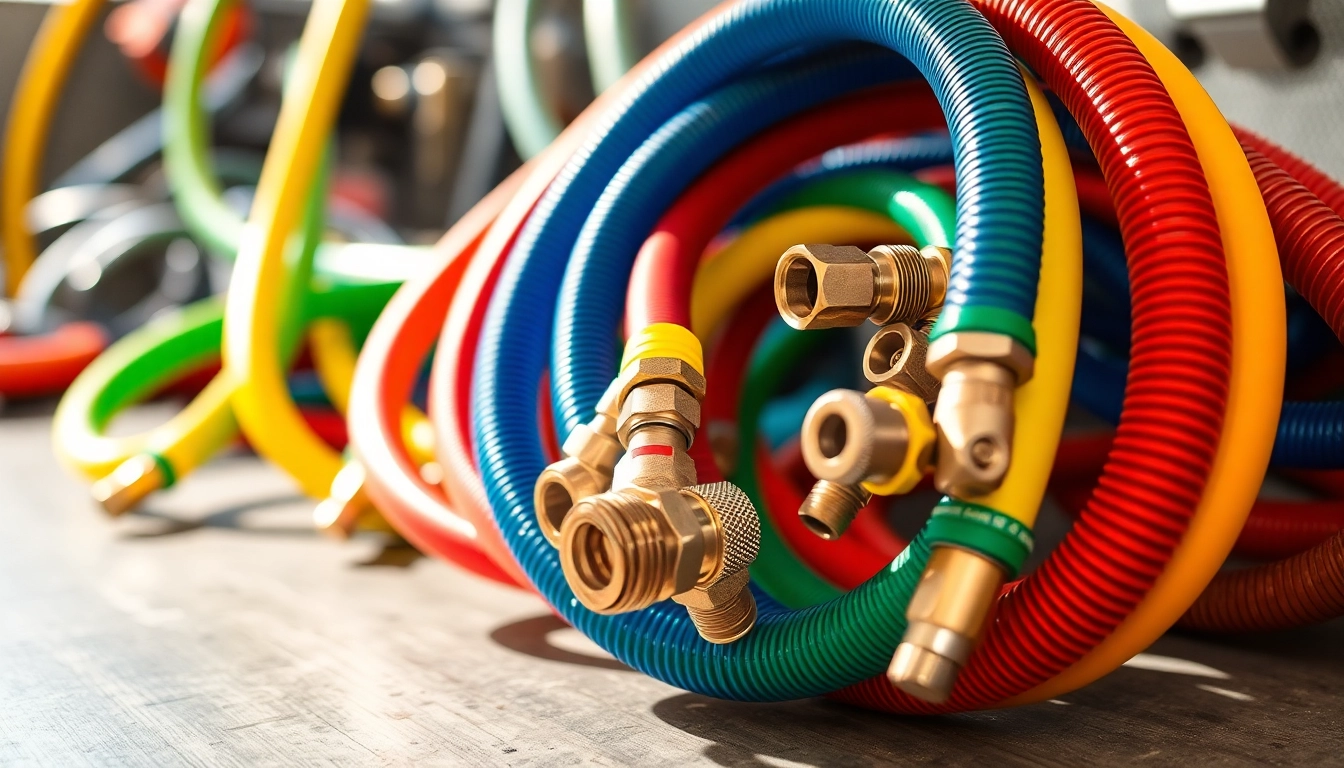Understanding Air Hoses and Fittings
What Are Air Hoses and Fittings?
Air hoses and fittings are essential components in pneumatic systems that use compressed air to power various tools and equipment. These hoses act as conduits for the air from the compressor to the tools, while fittings serve as connecters or adapters that help secure and direct airflow. Whether you’re an industrial worker, a contractor, or a DIY enthusiast, understanding the types and functions of air hoses and fittings is crucial to ensure optimal performance and safety in your projects.
Types of Air Hoses
Air hoses come in different types, each designed to meet specific needs. The primary categories include:
- Rubber Air Hoses: Renowned for their durability and flexibility, rubber hoses can withstand extremes of heat and pressure. They are ideal for heavy-duty industrial tasks but can be heavier than other options.
- PVC Air Hoses: Lightweight and cost-effective, PVC hoses are resistant to chemicals and UV rays. However, they may not perform well in extreme temperatures.
- Polyurethane Air Hoses: These hoses offer excellent flexibility, even in cold conditions. They are resistant to kinking, making them suitable for tight spaces and portable applications.
- Hybrid Air Hoses: A blend of rubber and PVC, hybrid hoses combine the benefits of both materials, offering flexibility and durability without the weight of rubber.
Common Air Fittings Used
Air fittings are crucial for connecting hoses to tools or compressors and come in various designs:
- Couplers: These are the female connectors that allow hoses to be attached to air tools or compressors. They come in different shapes and sizes according to the needs they serve.
- Plugs: Male connectors that fit into couplers. They ensure a secure connection and can be used in quick-connect systems for easy transitions.
- Adapters: Used to connect different sizes of threads or hose diameters, allowing flexibility in setups.
- Quick-Connect Fittings: These provide a fast and hassle-free way to connect and disconnect hoses from tools or compressors, essential for operations that frequently change tools.
Benefits of Quality Air Hoses
Improved Efficiency and Durability
Investing in high-quality air hoses and fittings significantly enhances the efficiency of pneumatic systems. Durable hoses constructed from quality materials can withstand wear and tear, reducing the frequency of replacements. This longevity not only lowers replacement costs but also minimizes downtime in industrial settings.
Reducing Air Leaks
Air leaks not only decrease system efficiency but can lead to increased energy consumption and costs. Quality fittings and hoses fit tightly, significantly minimizing the chances of leaks. Regular maintenance and inspections can further identify potential leak points early, ensuring systems operate at peak efficiency.
Choosing the Right Size and Style
Selecting hoses and fittings in the right size and style ensures that tools receive an adequate airflow without restriction. A mismatch can lead to sub-par tool performance, inefficiency, and potential safety hazards. For instance, using a hose that is too small can restrict air flow and pressure, affecting tool operation efficiency.
How to Select the Right Air Hose
Material Considerations
The material of an air hose significantly influences its performance. Consider the working environment and the specific requirements of the tools to determine the right material. For instance, in a temperature-controlled environment, a PVC hose might suffice, while a rubber hose may be more appropriate for high-heat industrial settings.
Length and Diameter Factors
The length of the air hose affects pressure loss; longer hoses can lead to greater pressure drops, which can impact tool performance. Generally, shorter hoses are better for applications that require consistent air pressure. Diameter, on the other hand, must match the fittings and tools used to ensure proper airflow without restrictions.
Special Features to Look For
Some hoses come equipped with additional features such as kink resistance, abrasion resistance, or foam insulation to combat temperature effects. When choosing, consider features that support flexibility and reduce maintenance requirements, especially if the hose will be regularly moved or uncoiled.
Installation and Maintenance Tips
Proper Connection Techniques
To ensure safe and effective connections, always ensure the fittings are clean and free of debris before connecting. The threads should be properly lubricated if necessary, and couplings should be tightened but not over-torqued, which can damage the threads and fittings.
Regular Maintenance Protocols
Routine maintenance checks should involve inspecting hoses and fittings for wear and tear, leaks, and ensuring that connections are secure. Regular cleaning of fittings can prevent buildup which can lead to malfunction. Recommended maintenance intervals vary by usage; high-use environments should check connections weekly while lower use may require monthly inspections.
Common Issues and Troubleshooting
Common issues include kinks, leaks, and performance drops. Kinks can lead to pressure drops; therefore, storing hoses properly and avoiding sharp bends during use is essential. Leaks can often be detected by listening for hissing sounds or soapy water tests. If leaks occur, inspect the fittings first; replacing worn or damaged fittings can often resolve the issue.
Best Practices for Using Air Hoses and Fittings
Safe Usage Guidelines
Safety should always be paramount when dealing with compressed air. Never exceed the rated pressure for hoses and fittings, and use appropriate personal protective equipment (PPE) when working around compressed air systems. Always inspect hoses before use; any evidence of damage, abrasions, or kinks should render the hose unusable until repaired or replaced.
Storing and Handling Tips
Proper storage of air hoses is crucial to extending their lifespan. Always coil hoses neatly and store them in a dry area away from direct sunlight and extreme temperatures. Consider using hose reels for organized storage and easy access.
Industry Standards and Compliance
Familiarizing oneself with current industry standards and regulations surrounding air tools and components can enhance safety and reliability. Standards relevant to air hoses and fittings include those set by the American National Standards Institute (ANSI) and the Occupational Safety and Health Administration (OSHA), which guide compliance in industrial and commercial environments.
